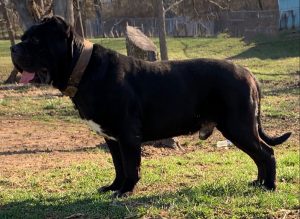Athletic dog breeds are like the sports stars of the canine world. With their energy, strength, and agility, these four-legged pals are more than just pets; they’re also ideal companions for active folks. Whether it’s a day out on the hiking trails, playing fetch at the park, or participating in dog sports, athletic dogs are always up for some action.
What exactly is an athletic dog breed? It’s a breed that has a natural inclination for physical activity and excels in agility, strength, and endurance. These dogs have a built-in zest for exercise and usually require regular and diverse physical engagements.
They usually have a strong, muscular build which helps them run faster and jump higher. A high energy level is another hallmark—these pups are not couch potatoes! They’re also known for their agility, which means they can move quickly and easily, making them great at tasks that involve running and jumping. Additionally, they tend to be highly intelligent and eager to please, which makes them easier to train.
Pro Tip: These dogs are not for first-time owners.
There are plenty of breeds that fall into the athletic category. Some of the rock stars in this category are the following:
- Border Collie – known for its intelligence and agility
- Labrador Retriever – loved for its friendly nature and versatility
- German Shepherd – a true workaholic and one of the most trainable breeds
- Australian Shepherd – which is not only smart but also incredibly good at herding
Read Can dogs eat Jicama?
These are just a few examples, but the list is pretty long.
Table of Contents
The Common Causes Of Injuries
Understanding the root causes of injuries in athletic dogs is essential for effective prevention and management.
- Overexertion
Sometimes, an athletic dog’s enthusiasm can be its own worst enemy. They might overdo it and not know when to take a break. This can lead to muscle strains, fatigue, and even more serious injuries.
- Improper Training
Just like human athletes, dogs need to be trained properly. This means gradually building up their strength and endurance and not pushing them too hard too soon. Training should also be varied to avoid stressing the same muscles over and over.
- Pre-Existing Health Conditions
Your furry friends may also have some health conditions that make them more susceptible to injuries. For example, some breeds are genetically predisposed to hip dysplasia or arthritis. Being aware of your dog’s health history is crucial in planning an exercise routine that’s safe for them. To avoid such problems, get a dog from an ethical and well-reputed breeder.
- Lack Of Proper Nutrition And Care
Just like humans, dogs need a balanced diet to stay strong and healthy. This includes the right amount of nutrients to support their high energy levels. Regular vet check-ups are also essential, as well as making sure they have a safe environment to play and exercise in.
8 Common Injuries In Athletic Dog Breeds
Athletic dog breeds, with their boundless energy, are susceptible to a range of injuries. Here are eight common injuries they might encounter, along with an insight into what causes them and how they can be prevented or treated.
- Anterior Cruciate Ligament (ACL) Tears
ACL tears involve the ripping of a crucial ligament in the dog’s knee, causing pain and instability. This injury is often a result of sudden twists or movements, particularly during high-speed activities like chasing a ball.
Regular, moderate exercise can strengthen the surrounding muscles and reduce the risk of ACL tears. If an ACL tear occurs, Sunnyside Vet Clinic recommends prompt veterinary intervention, which may include rest, medication, or surgery.
- Hip Dysplasia
Hip dysplasia is an abnormal formation of the hip socket, which can lead to arthritis and pain. It’s often genetic but can be exacerbated by rapid weight gain and high-impact exercise. Maintain a healthy diet and weight for your dog, and engage in low-impact exercise. Veterinary treatment may include medications, physical therapy, or surgery.
- Fractures
Fractures in athletic dogs usually entail breaks in the bones, which can range from hairline cracks to complete breaks. These injuries often result from accidents, falls, or high-impact collisions during play. To prevent fractures, it’s essential to provide a safe environment for your dog’s activities and monitor the level of roughness during play. When a fracture occurs, treatment usually involves immobilizing the bone, and in some cases, surgery might be necessary.
- Tendon Injuries
Tendon injuries are another common issue and involve damage to the tendons, which are the fibrous tissues that connect muscles to bones. Repetitive overuse or sudden, excessive force often causes these injuries. Preventive measures include incorporating strengthening exercises and avoiding repetitive movements. If an injury occurs, treatment might encompass rest, medication, and physiotherapy.
- Muscle Strains
Muscle strains refer to injuries where muscle fibers are overstretched or torn, often due to overexertion, slipping, or failure to warm up before exercise. Preventing muscle strains involves allowing your dog to warm up gradually before exercise and avoiding slippery surfaces. Treatment typically includes rest, applying ice packs, and administering anti-inflammatory medication under veterinary supervision.
- Bloat (Gastric Torsion)
Bloat, or Gastric Torsion, is a life-threatening condition where the stomach fills with gas and twists upon itself. Eating too quickly, exercising soon after eating, or having a genetic predisposition can cause bloat. To prevent it, feed your dog smaller, more frequent meals, and avoid rigorous exercise right after eating. Bloat is an emergency that requires immediate veterinary attention.
- Heatstroke
Heatstroke in dogs occurs when the body temperature escalates to a dangerous level, usually due to excessive exposure to heat or exertion in hot weather. Providing ample water, and shade, avoiding exercising in peak heat, and never leaving your dog in a parked car are vital preventive measures. If heatstroke occurs, immediate cooling and hydration are critical, and emergency veterinary care is needed.
- Paw Pad Injuries
Paw pad injuries encompass cuts, tears, or burns on the soft pads of a dog’s feet, caused by rough terrain, hot surfaces, or chemicals. Using dog boots, steering clear of hot pavements, and regularly cleaning your dog’s paws are effective preventive measures. For existing injuries, cleaning the wound and consulting a veterinarian if it’s severe or not healing is advisable.
Being vigilant and informed about these common injuries can help ensure that your athletic dog stays in top shape. Remember, timely prevention and appropriate care are key to a long, healthy, and active life for your furry companion.
The Importance Of Proper Training And Conditioning
Customized training plans for athletic breeds are essential since these dogs have unique physical attributes and energy levels. Tailored programs that take into consideration the breed’s strengths and limitations can optimize performance while minimizing the risk of injury.
Rest and recovery are as vital as exercise. Allowing muscles to heal and energy levels to be replenished is crucial in preventing overexertion and subsequent injuries.
Nutrition for athletic breeds should focus on providing the energy needed for their activities and promoting muscle repair. A balanced diet with proper proportions of proteins, fats, and carbohydrates, along with essential vitamins and minerals, is imperative.
Conclusion
Familiarity with the common injuries that athletic dog breeds face, and how to prevent or treat them, is critical for any responsible dog owner. Through awareness, prevention, and proper treatment, the bond between you and your athletic dog can be one of joy and fulfillment for years to come.
Recommended read – Australian Cobberdog Characteristics










